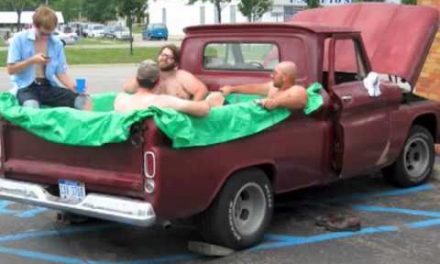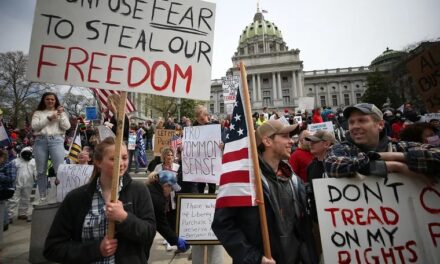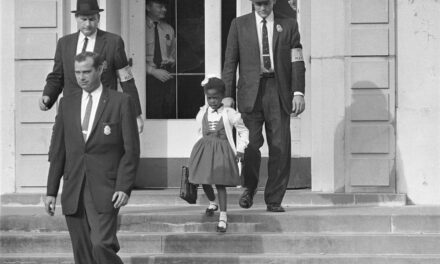When a society becomes overly stratified, when those with the most live lives that are mere fantasies to those at the bottom. the lords and ladies of that culture build themselves fortresses. Paths don’t lead directly toward doors, they become switchbacks with blind turns, usually leading uphill. There are heavy barricades near the doors, sometimes dressed up with flowers, but barricades none the less. Armed guards and other security measures await you when you walk through those doors. Everything is geared up to beat you over the head with the idea that the location is “secure”, though who it is being secured for isn’t always apparent. Our culture, especially in government buildings and corporate headquarters and campuses, has been recreating twenty-first century version of the medieval keep for years now. Since 9/11, they’ve taken the attacks as license to create cityscapes of fear:
To appreciate how America has changed since 9/11, walk slowly through any major city. What you’ll see dotting the landscape is the physical embodiment of fear. Security installations put up after the attacks continue to block public access and wrangle pedestrian traffic. Outside Manhattan’s Port Authority Bus Terminal, garish purple planters menace rush-hour pedestrian traffic. The gigantic planters have abandoned all horticultural ambition, many of them blooming with nothing more than trash and untilled dirt. “French barriers,” steel-grate barricades meant for controlling crowds, ring many landmark sites — including San Francisco’s Transamerica Building — like beefy bodyguards protecting starlets. Then there are the bollards, the cylindrical vehicle-blocking posts that are so pervasive you wonder if they’ve mastered asexual reproduction. In Washington, bollards surround everything. Not since Confederate Gen. Jubal Early attacked the city in 1864 has the nation’s capital felt so under siege.
It’s not just the barriers, it’s also the buildings. Since 9/11, risk consultants working for police departments, federal agencies and insurance companies have wrested control over many new construction plans. “There’s a sense that security experts are acting as the associate architects on every project built today,” says Paul Goldberger, the architecture critic of the New Yorker. Consultants tend to encourage architectural bulk at the expense of grace. As a prime example, Goldberger points to the Freedom Tower, the skyscraper at the center of the proposed new Trade Center site. After the New York Police Department determined that an early design was vulnerable to truck bombs, the building’s architect, David Childs, of the firm Skidmore, Owings and Merrill, was forced to move the structure far back from the street, and to turn its lower 20 stories into a windowless reinforced concrete pedestal covered in glass. “It’s a pretty grim piece of architecture,” Goldberger says of the tower. “It doesn’t advertise freedom to the world, it advertises fear.”
9/11 was only an excuse to ramp up a trend that was already underway. Even our gaze, especially through cameras, is coming under more onerous restrictions. Watch what you say, watch what you look at, watch were you walk and where you travel, and watch what you carry when you go there. If TATP is such a threat, when will we be told that the soda bottle we’re carrying can’t come into the building with us?
The endless hammering of fear coming out of our media, out of our political leaders, out of our business leaders, out of the ring of coworkers standing around the water cooler, that relentless drone of “be afraid” that washes over us everyday for years has increasingly been given physical form, and the majority of the citizenry seem eager to wallow in it. A nation of cowards, running from cover to cover.
But others fear that security measures may be inhibiting urban connections. Setting buildings far back from the street, placing them atop concrete blast shields, crowding sidewalks with barricades, constantly screening people as they enter or exit buildings, electronically surveilling them at every waking moment — these measures push us apart and foster our fears and suspicions. The effect is physical as well as psychic. Goldberger points out that you used to be able to walk around Manhattan, both on the sidewalks and through the lobbies of large buildings, without showing any credentials. Today that’s nearly impossible because entering nearly every building requires passing through a security checkpoint. The checkpoint culture weighs on the soul, reminding us at every point that we live in a dangerous time, and that anyone we see might seek to do us harm.
Make no mistake, the “war on terra”, like the “war on drugs”, isn’t really about all of the wonderful family values that the cabal running this country (and that includes BOTH poltical parties and much of the corporate leadership as well) tells us it’s about. It’s about control. It’s about greed. It’s about manufacturing consent for widening war. When you’re confronted everywhere by blockades and guns and surveillance it erodes any illusion of freedom. The environment we create for ourselves is becoming both a prison and a reflection of how deeply irrational American society has become.
Many designers and planners agree that the practice of setting new buildings back from the street is one of the most troubling security impositions. In “The Death and Life of Great American Cities,” Jane Jacobs told of the “intricate sidewalk ballet” that characterized the stretch of Hudson Street in Greenwich Village, where she lived in the 1960s. The ballet involved locksmiths, shopkeepers, butchers, longshoremen, teenagers, tailors, toddlers — people of all stripes whose everyday interactions on the packed street, she argued, provoked a sense of “casual public trust” in the community. Today’s security installations reduce our chance encounters on the street and risk breaking our casual public bonds.
“Cities basically operate off their street life, and if buildings become just big blank walls because people are afraid of the street, it’s fundamentally contradictory to what cities are all about,” Chakrabarti says. He adds: “You look at the charts that a lot of security people use and they’ll say, ‘The building has to be X-hundred feet from the street.’ You start thinking about that en masse and what you’re talking about is the suburbs. That kind of thinking, when it starts becoming cumulative, could really endanger something that we really want and need, which is a dense urban environment.”
This isn’t just a problem in our big urban centers. It’s all across our landscape. A country on a continual war footing can’t remain healthy. We need to take a step back and realize what we’re giving up, realize that we’re blowing these threats all out of proportion while our very infrastructure crumbles beneath our feet. It’s a collapsing freeway overpass that is more likely to snuff out your life than some fanatic suicide bomber. One of our great cities goes unrecovered while we fortify every nook and cranny elsewhere. It’s time to get some perspective, grow back our spines. To continue down this path is to willingly sell out our souls. Perhaps we’re too far gone and we’ve already done so. America the big armed suburb, with frightened eyes peeking out through ballistic glass.









